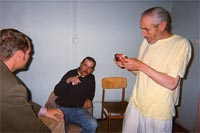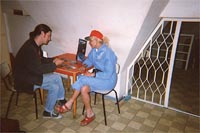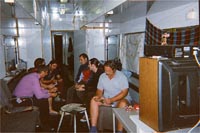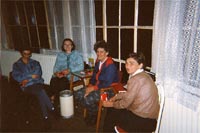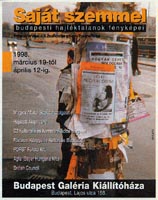 |
 |
|
|
|
|
A
project by Big Hope: Erhardt Miklós / Dominic Hislop.
|
|
Between
July 1997-February 1998, 40 disposable cameras were given to homeless
people in Budapest. Each participant was asked to take pictures
of whatever they felt to be interesting or important in their everyday
experience and later interviewed about the results. Scroll down
to read more info or click on the words 'inside out' above to enter
the full site in English.
|
|
Ezeket a képeket Budapesten élõ hajléktalanok készítették, egyszerû, eldobható fényképezõgépekkel, az elmúlt több mint fél év során. A munkához semmiféle tematikus jellegû instrukciót nem kaptak. Az elkészült képek alapján minden résztvevõvel rövid interjú készült. Klikkelj a "Saját szemmel" cimsorra a magyar változathoz! |
Participant Photographs & Interviews
The 'Saját
szemmel/Inside Out' project began in July 1997. Between then
and February 1998, around 40 homeless people living in Budapest
were given simple colour disposable cameras and invited to take
photographs of whatever they felt to be important or interesting
in their everyday experience, in the knowledge that their pictures
would later be viewed publicly as part of an exhibition and web
site. The participants were approached on a fairly random basis
in the city's metro stations and homeless shelters. When the prints
were ready we recorded an interview with each photographer about
their pictures. Through the support of our sponsors we were able
to recompense the participants for their work.
The work was
presented in two exhibitions. One was in the the established art
context of the Budapest Galéria, (Budapest III.,
Lajos utca 158.) Around 100 colour photographic enlargements (3
to 4 pictures by each participant) were exhibited along with their
corresponding comments. The exhibition was opened on 19 March
1998 by Sándor Kardos , filmmaker and curator
of the Horus photographic archive, and ran until 19 April.
A 20 page black and white catalogue including at least one photograph
and text by each participant was available during the exhibition.
Texts on 'saját szemmel/inside-out' by Miklós ‘Saját Szemmel’, Hajszolt Hírlap. (March-April 1998) p.58-60. 'Saját Szemmel, notes on a photo project', Törökfürdő.(Winter 1999) p. 2-4. (In Hungarian) 'The Structure of Avoidance ' (with Duna Maver), Subsol, Webzine - 'http://Subsol.c3.hu', (February, 2001). Texts on 'saját szemmel/inside-out' by Dominic 'saját szemmel/inside out ' description (April, 2001) - not published 'Homeless project' Written for a 'Shedhalle' magazine and web-zine which coincided with the ‘Moneynations: Border Economies’ conference in Zürich, (23-25 October, 1998). Other writings on 'saját szemmel/inside-out' (in English): Abildgaard, Dorthe. ‘Down and Out in Budapest and Vollsmose’ , India Art, [Apr 2001] Crouse, Charity, ‘Hungarian Homeless Capture Street Life’, StreetWise, Chicago, USA. (27 Oct - 9 Nov, 1998.) p.4. & p.21. Coleman, Sam. ‘Life on the Streets Turned Inside-Out’, Budapest Week (2-8 April 1998) p.23. (in Hungarian): Bihari, László. ‘A Kenyérverő Ember’, Magyar Hirlap. (4 April 1998.) p.14. Palotai, János. ‘Expó’, Élet és Irodalom. (17 April 1998.) p.18. Schubert, Gusztáv. ‘Képtelenek’, FilmVilág (illustrations), (May 1998) Tillmann, J.A. ‘A szélek észlelése’, Élet És Irodalom. (17 April 1998.) p.16. Trencsényi, Zoltán. ‘Fényből Fabrikált Mindennapok’, Népszabadság. (20 March 1998.) p.29. (in German): Richardson, Joanne. 'Die O/Est-Ethik der Gegen-Dokumentation', in 46th International Short Film Festival, Oberhausen, catalogue (2000) p. 82. Preuss, Rita. ‘Gulasch-Kapitalismus’, Zitty, (28 Aug 1999.) p.57. Herbestreuth, Peter. ‘Zufallsfunde im zerstörten Haus’ Der Tagesspiegel, (30 Aug 1999.) p.29. Suhr, Constanze. ‘Hungry Hungary’, Kunst. (30 Aug 1999.) p 76. Tillmann, J.A. ‘Die Wahrnehmung der Runder’, Pester Lloyd. (3-6 June 1998.) p.1. Publication of photographs and texts Saját Szemmel / Inside Out. Photographs and comments, inVariant, (Spring 2000). Cover of supplement with text by Grant Kestler on Socially Engaged Art Practice. Radio features (all 1998) Petőfi Rádió, Kossuth Rádió, Budapest Rádió, Calypso and Juventus Rádió Television features (all 1998) ‘72 Óra’, TV3. ‘Fehér Éjszakák’, Duna TV. ‘Déli Műsor’, ‘Háló’, ‘Napkelte’, MTV1. ‘Árnyékfogó’, MTV2. Estimating
the number of homeless is considered a problematic issue in both
Hungarian and international literature. Difficulties arise from
the definition of homelessness (i.e. who do we consider to be
homeless?) and also from the heterogeneity and geographic mobility
of this group. There is however an understanding of the increasing
numbers of homeless in Hungary. It is estimated that around 20-50,000
homeless people live in Hungary, 15-20,000 of which are in the
capital, Budapest.
* Communities for a sustainable future * The Mad Housers photobook. * Real Change News * Shelter UK * Z Magazine * 0100101110101101.ORG * Subsol * Indymedia * Big Issue links * European Roma Rights Centre * Roma Page * Nettime
We are grateful
to the following for their sponsorship:
Thanks. We are indebted to the following for all their help in making this project possible. Vecsei Miklós, Kassai Melinda, Capusan Andrea, Dávid Judit, Gyuris Tamás, Sugár János, Peternák Miklós, Török Tamás, Tillmann József Attila, Krémer Balázs, Iványi Gábor, Gurály Zoltán, Gáncs Andrea, Oran Mc Cuirc, Kardos Sándor, Kincses Károly, Várnagy Tibor, Sükösd Miklós, Körösiné Egyed Orsolya, Papp Zoltán, Glósz Béla, Benedek Gáspár, Gróf Ferenc, Lendvai Ádám, Révai Gábor, Szebenyi Mariann, Lénárt Imre, Körösi Péter, Nagy Gabriella, Láng Imola, Mentes Tamás, Keresztúri Gábor, Tatár Attila, Sam Ainsley, Roger Palmer, David Harding, Francis McKee, John Calcutt, Tímár Katalin, Hecker Péter, Zalka Imre, Iványi Marcell, Polgár Sándorné, Maria Bredican, Helen Bartlett, Szabó Eszter Ágnes, Farkas Gabriella, Szövény Anikó, Detvay Jenő, Hangyál Judit, Eln Ferenc, Stefanics István, Tarnai Zoltán HTML / Javascript: Thanks to Benedek Gáspár - gbenedek@c3.hu Translations. Oran McCuirc Contact
and other works. |
||||||||
 Big Hope:
Erhardt Miklós / Dominic Hislop: www.bighope.hu
e-mail: bighope [at] bighope [dot] hu
Big Hope:
Erhardt Miklós / Dominic Hislop: www.bighope.hu
e-mail: bighope [at] bighope [dot] hu |


